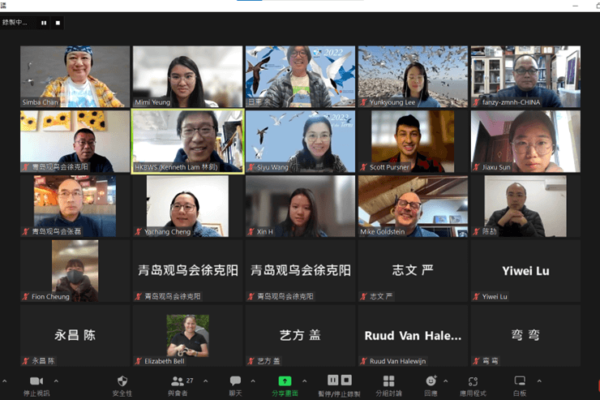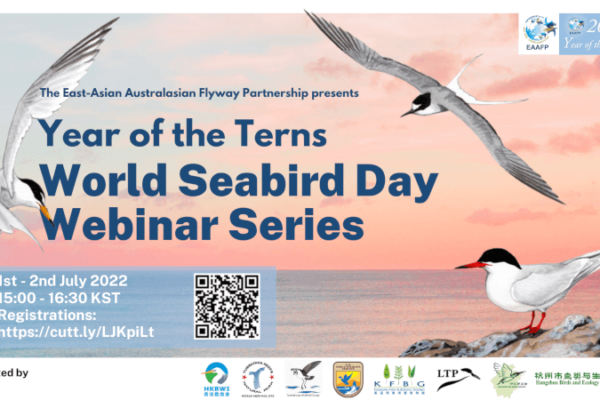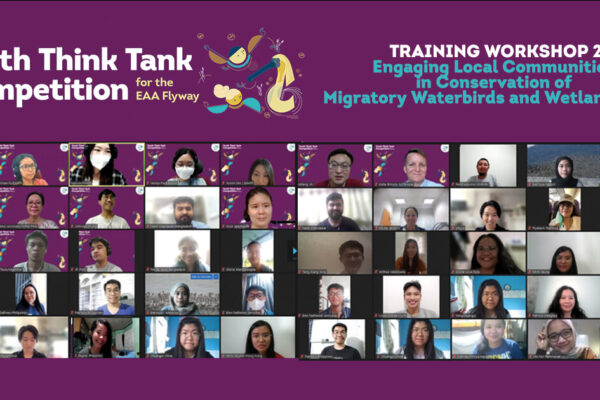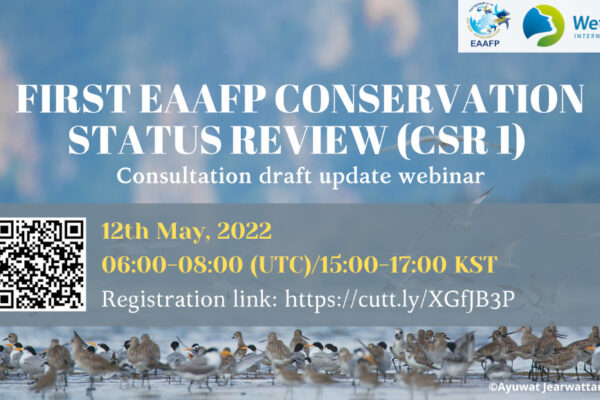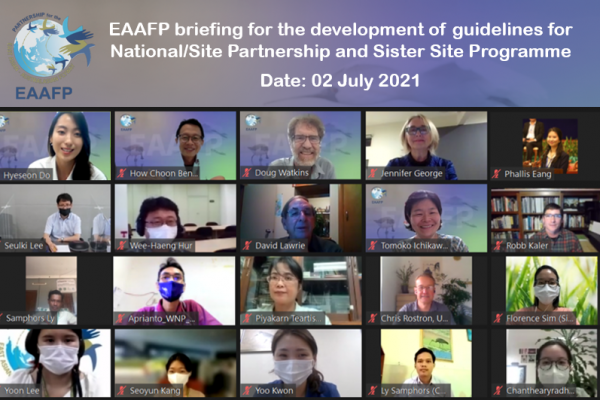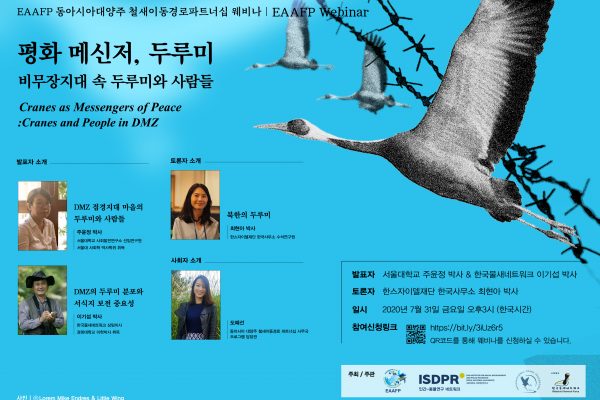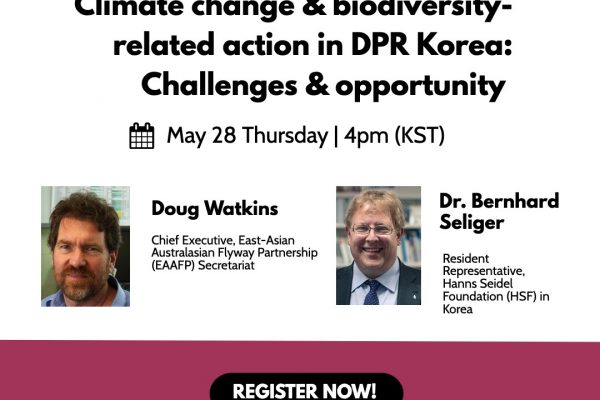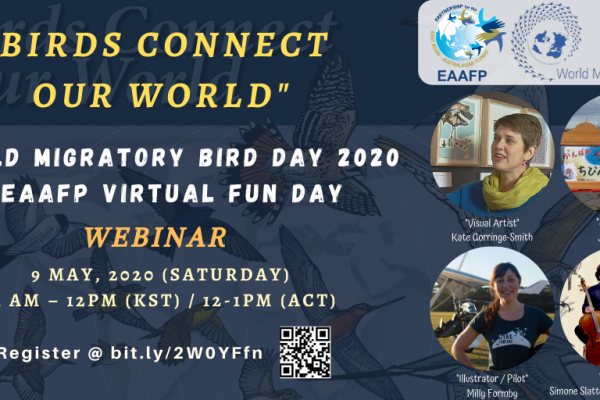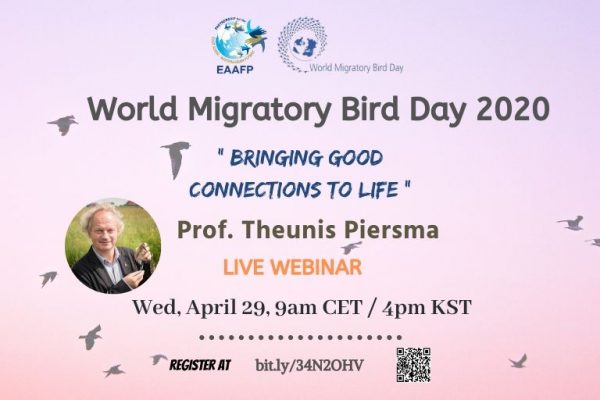-
Webinar on Chinese Crested Tern in the Yellow Sea and Seabird Conservation in China
Listed as Critically Endangered on the IUCN’s Red List, the Chinese Crested Tern’s global…
Continue reading -
“Year of the Terns” World Seabird Day Webinar Series
“Year of the Terns” World Seabird Day Webinar Series Brief Introduction To raise awareness among EAAFP Partners, researchers, conservationists, and the general public about seabirds in the East Asian – Australasian Flyway (EAA Flyway), while promoting the exchange of information and collaboration on seabird conservation in the Flyway, the EAAFP Secretariat and the Seabird Working Group initiated the “Year of the Terns” in 2022. The World Seabird Day Webinar Series is one of the campaign activities for “Year of the Terns.” With the aim of showcasing and raising awareness for seabird conservation work along the EAA Flyway, the webinar series consist of two sessions, to launch the Asia Seabird Colony Registry, as well as showcasing work on tern species and their conservation. Date/Time: 1 – 2 July 2022 (15:00 – 16:30 KST on both dates) Topics: Session 1 (1 July): Launch of the Asia Seabird Colony Registry Session 2 (2 July): Showcase of tern conservation projects in EAA Flyway Organizers: EAAFP Secretariat, EAAFP Seabird Working Group, Australasian Seabird Group, Hong Kong Bird Watching Society, Tubbataha Reefs Natural Park. Meeting Platform: Zoom Language: English Registration: https://us02web.zoom.us/meeting/register/tZ0rce6prD8iGtax5wFiPEf6GfTOomM8A58c (https://cutt.ly/LJKpiLt) Overall Programme Day Programme Speakers Day 1 Welcoming Speech Doug Watkins, Chief Executive of EAAFP Secretariat Robert Kaler, Chair of EAAFP Seabird Working Group Presentation on Year of the Terns Vivian Fu, EAAFP Communication Officer Introduction of World Seabird Registry Robert Kaler, Chair of EAAFP Seabird Working Group Presentation on the launch of the Seabird Breeding Registry in EAAF Simba Chan, Seabird Working Group Panel Discussion Moderated by Yat Tung Yu, Coordinator of EAAFP Seabird Working Group Panelists: Simba Chan, Angelique Songco, Site Manager of Tubbataha Reefs Natural Park, Philippines, Miran Kim, Seabirds Laboratory of Korea, Republic of Korea Nicholas Carlile, Australasian Seabird Group Day 2 Welcoming Speech Yat-tung Yu, Coordinator of EAAFP Seabird Working Group Primer screening of “Terns Operation” about Chinese Crested Tern, by Fung Hong Shing 1. Presentation on Aleutian Tern Robert Kaler, EAAFP Seabird Working Group Chair 2. Presentation on Little Tern Professor Wataru Kitamura, Tokyo City University 3. Presentation on Chinese Crested Tern Siyu Wang, Zhejiang Natural History Museum 4. Presentation on Terns breeding in Hong Kong John Chung, Hong Kong Bird Watching Society 5. Presentation on River Tern Zheng Xi, Kadoorie Farm and Botanic Garden – Hong Kong 6. Presentation on Black Noddy Retch Pagliawan-Alaba, Research Officer, Tubbataha Reefs Natural Park 7. Presentation on White Tern Nicholas Carlile, Australasian Seabird Group Q&A Moderated by Yuna Kim, Australasian Seabird Group Webinar Speakers and Moderators: Day 1 “Launch of the Asia Seabird Colony Registry” Date: 1st July 2022 (15:00 – 16:30 KST) Registration Link: https://us02web.zoom.us/meeting/register/tZ0rce6prD8iGtax5wFiPEf6GfTOomM8A58c Key speaker Simba Chan Seabird Working Group Panelists Angelique Songco Site Manager, Tubbataha Reefs Natural Park, the Philippines Angelique Songco has more than 20 years of experience as a site manager of Tubbataha Reefs Natural Park, an UNESCO World Heritage Site and Flyway Network Site. Referred to as “Mama Ranger,” Angelique is also a member of the EAAFP Seabird Working group and works on the frontier in safeguarding important sites. Miran Kim Seabirds Laboratory of Korea Miran Kim is working in the Seabirds Lab of Korea. During her PhD, she studied egg morphology and hatching asynchrony in gulls. She has worked for the conservation of Swinhoe’s storm petrels and long-term monitoring of Black-tailed gulls. Recently, she is investigating the impacts of marine debris and bycatch on seabirds. Nicholas Carlile Australasian Seabird Group Nicholas commenced ecological research with the Australian Museum 1986 and since 1988 with the NSW States government. His work includes island biodiversity restorations and surveys, research into seabirds and their translocation. While focusing mainly on petrels, he has researched Little, Sooty and White terns as well as Boobies and Tropicbirds. Moderators Vivian Fu Communication Officer, EAAFP Secretariat Yat Tung Yu Director, Hong Kong Bird Watching Society Coordinator, Seabird Working Group Day 2: “Showcase of Tern Conservation Projects in the EAA Flyway “ Date: 2nd July 2022 (15:00 – 16:30 KST) Registration Link: https://us02web.zoom.us/meeting/register/tZ0rce6prD8iGtax5wFiPEf6GfTOomM8A58c Speakers Robert Kaler Chair, Seabird Working Group Robb Kaler is a biologist with the U.S. Fish and Wildlife Service in Alaska, USA. Robb serves as chair of the EAAFP Seabird Working Group is interested in developing collaborations towards broad conservation goals that inform management decisions and promote seabird conservation. Professor Wataru Kitamura Associate Professor, Tokyo City University Wataru Kitamura Ph.D. is an associate professor at Tokyo City University and the president of NPO Little Tern Project aiming for conservation of the Little Terns on a rooftop in Tokyo. His main research area is conservation biology of avian species such as giving solutions for bird collisions to wind turbines and interaction between alien and native species. Siyu Wang Research Associate, Zhejiang Museum of Natural History Siyu Wang, research associate of Zhejiang Museum of Natural History, now mainly working on Chinese Crested Tern and Scarly-sided Merganser conservation. Since 2014, I participates in the Chinese Crested Tern Project as a team member. Except from research work, I'm also responsible for Science Popularization of Chinese Crested Tern and other birds. John Chung Hong Kong Bird Watching Society After graduating from the Chinese University of Hong Kong with an MPhil degree, John Chung devotes himself to bird research and conservation. He is currently a research officer in the Hong Kong Bird Watching Society. He is responsible for coordinating bird ringing, tern study, and citizen science programs in Hong Kong. Zheng Xi Kadoorie Farm and Botanic Garden - Hong Kong Zheng Xi is a Conservation Officer of Kadoorie Farm & Botanic Garden. He has been actively involved in several key conservation projects to minimize biodiversity loss in China and Cambodia, including the conservation of River Tern and Hornbills in western Yunnan of China. Retch Pagliawan-Alaba Research Officer, Tubbataha Reefs Natural Park Retch is the Research Officer of the Tubbataha Reefs Natural Park in the Philippines. She began working on seabirds in 2013 as part of her MSc studies. One of their seabird conservation projects is the restoration of the Black Noddy population in TRNP. Nicholas Carlile Australasian Seabird Group Nicholas commenced ecological research with the Australian Museum 1986 and since 1988 with the NSW States government. His work includes island biodiversity restorations and surveys, research into seabirds and their translocation. While focusing mainly on petrels, he has researched Little, Sooty and White terns as well as Boobies and Tropicbirds. Moderators: Yat Tung Yu Director, Hong Kong Bird Watching Society Coordinator, Seabird Working Group Yuna Kim Australasian Seabird Group Supporting Organizations Playback of the Webinar Day 1 Launch of the Asia Seabird Colony Registry Day 2 Showcase of conservation work of terns EAAF Contact If you have any inquiries, please feel free to contact Mr. Yat-tung Yu, Coordinator of the Seabird Working Group at yyattung@hkbws.org.hk; or Ms. Vivian Fu, Communication Officer of EAAFP at communication@eaaflyway.net.
Continue reading -
Youth Think Tank Competition for EAA Flyway – 2nd Training workshop
On 28th - 29th May, the Youth Think Tank Competition in the East Asian-Australasian Flyway (EAAF) engaged youth participants with a webinar and in-depth training workshop on Engaging Local Communities in Conservation of Migratory Waterbirds and Wetlands. One in a series of workshops that aims to build capacity for young conservationists on wetland and migratory waterbirds conservation in the flyway across various disciplines, the 2-day virtual workshop was organized by the EAAF Partnership Secretariat with the help of the youth organizing team. More than 100 youth actively participated in the discussions and workshops. Day 1 The workshop opened on 28th May 2022 with a webinar, “Understanding Nature-based Solutions and Local Community Engagement in Conservation of Migratory Waterbirds and Wetlands.” The 1-hour webinar focused on presentations from speakers, Ms. Kathryn Bimson, Programme Officer for IUCN Regional Asia Office, and Mr. Jiefeng Jin, Conservation Officer for the International Crane Foundation. The first presentation, given by Ms. Kathryn Bimson, was an introductory presentation on Nature-based solutions and was followed by an introductory presentation on Engaging local community in conservation by Mr. Jiefeng Jin. Both presentations helped participants ease their way into the topic and the in-depth training workshop, “Engaging Local Communities in Conservation of Migratory Waterbirds and Wetlands” that came afterwards. [PPT Materials] Introduction to Nature-based Solutions (link) / Introduction to Engaging Local Community in Conservation (link) The in-depth workshop was led by Ms. Mercy Kariuki, Programme Officer (Local Engagement and Empowerment Programme) from BirdLife International and focused on “Engaging Local Communities in Conservation of Migratory Waterbirds and Wetlands”. She emphasized the significance of Free, Prior and Informed Consent (FPIC) in the process of conservation and how the work is increasingly adopting a human rights-based approach. To delve further into the topic, the presentation was followed by a case study by Mr. George Ndung’u Muigai, Founder of the Cranes Conservation Volunteers, on the conservation of Cranes in Kenya. During his presentation, Mr. Muigai shared on-the-ground experiences engaging with the community and exchanged practical advice with the youth participants. [PPT Materials] Engaging Local Communities in Conservation of Migratory Waterbirds and Wetlands (link) / Conservation of Cranes in Kenya (link) The breakout session, participants discussed the positive and negative relations between conservation and people, so that they could learn to think in different perspectives – from local communities to conservation. The participants shared actual experiences from their respective regions and project implementations. Day 2 The in-depth workshop continued on 29th May with a short summary presentation from Ms. Mercy Kariuki before delving into a case study from Amy M. Lecciones, Executive Director of the Society for the Conservation of Philippine Wetlands, Inc who tackled Empowering Communities for Managing Agricultural Wetlands. In her presentation, Amy shared the case in Paligui Wetlands (a part of the greater key biodiversity area of Candaba Wetlands) of how local farmers were trained to be local eco-tour guides. Amy enumerated some key activities for community engagement and social challenges with the proposed conservation measures taken in Paligui. (PPT Materials) Following next was a case on Hong Kong Fishpond Conservation Scheme presented by Mr. Johnson Chung of The Hong Kong Bird Watching Society. Mr. Johnson shared how local fishermen helped to enhance the biodiversity of fishponds within the Ramsar Site and being an important player in the conservation project. Johnson shared different ways to motivate the local communities as well as the general public to support the management agreements. The outputs were beyond conserving migratory birds but also benefitted local fishermen while maintaining traditions and cultures in Hong Kong. (PPT Materials) The last case study was presented by Professor Wataru Kitamura of Tokyo City University on the Little Tern project. He shared how the once-disappeared population of Little Tern was brought back to the urban areas in Tokyo Bay area. The project demonstrated the success and need for a strong scientific base, and how it can be developed into a good citizen science programme to engage the locals and general public garner their support. It was also an innovative solution to create habitats for the birds with the use of the rooftops of building in the middle of the city. (PPT Materials) After that, the participants broke out into groups to practice stakeholder analysis of the different case studies that were presented. Youth participants shared their perspectives on identifying stakeholders and ideas on engaging them with participatory conservation objectives. [Webinar] Understanding Nature-based Solution and Local Community Engagement in Conservation of Migratory Waterbirds and Wetlands [In depth Workshop] Engaging Local Communities in Conservation of Migratory Waterbirds and Wetlands: Session 1 [In depth Workshop] Engaging Local Communities in Conservation of Migratory Waterbirds and Wetlands: Session 2 Evaluation: All 20 participants had an increase in learning for the topic of nature-based solutions. In the pre-workshop survey, half of the participants responded that they had some familiarity with the topic. In the post-workshop survey, however, 90% responded they were now familiar or ‘ready to go pro’ with nature-based solutions. All participants were satisfied and found what they learned during the workshop useful in their volunteer/work. Participants rated these three components with the highest scores: 1) trainers and speakers of the workshop (4.5/5); 2) case study presentations (4.5/5); 3) contents of the workshop (4.5/5). The most valuable learnings/ takeaways for the participants were: 1) Free, Prior and Informed Consent, 2) Stakeholder mapping and analysis and 3) Nature-based Solutions. Takeaways: Participants wrote that most valuable learnings/ takeaways for the workshop was: 1) Free, Prior and Informed Consent, 2) Stakeholder mapping and analysis and 3) Nature-based Solutions. In the words of the Flyway youth: “What really stayed in my head and in my notes also is the quote "Recognizing diversity and engaging stakeholders helps in building legitimacy, developing innovative solutions, enhancing transparency, and most importantly, in upholding social equity." “It is evident that we are currently experiencing biodiversity loss. Hence, it is a must to take action. However, there are various factors that we need to consider first. For example, the effects of the conservation programs that we want to implement on the local communities and vice versa. As conservationists, we should understand the social contexts. A way for us to plan everything is to create a stakeholder analysis. It is a process for us to be able to map and identify the target people before the project begins. Acknowledgment The Youth Think Tank Competition for the EAA Flyway Organizing Team acknowledges the great contribution from the speakers and trainers: Mercy Kariuki, George Ndung’u Muigai, Amy M. Lecciones, Johnson Chung, and Wataru Kitamura, as well the youth organizing team: Frances Alvares, Jord Earving Gadingan, Oscar Yu, Thura Soe Min Htike, Yeonju Park, Yuji Lim and Yoomi Sim. The webinar was moderated by Ms. Yoon Kyung Lee, External Relations Manager of the EAAFP Secretariat. The in-depth workshops were co-moderated by Ms. Yuji Lim, Ms. Yeonju Park, Ms. Yoomi Sim from the EAAFP Secretariat and Mr. Thura Soe Min Htike from Myanmar. Ms. Vivian Fu, Communication Officer of the EAAFP Secretariat led the coordination of the workshop. To learn more about the speakers and trainers click here. For more on the Youth Think Tank Competition click here.
Continue reading -
First EAAFP Conservation Status Review (CSR1) consultation draft update webinar
Following the MOP 10 adopted Decision 12 “Development of a Conservation Status Review of Migratory Waterbird Populations for the EAAFP” in 2018, the first EAAFP Conservation Status Review (CSR1) was kicked off on 8th April 2021, to ensure researchers, government agencies, conservationists and other stakeholders can get access to up-to-date information of waterbird population estimate. After one year of extensive consultation and valuable feedback, the EAAFP Secretariat jointly with Wetlands International are pleased to host a webinar to present the final draft of the First EAAF Conservation Status Review (CSR1) with all Partners, Working Groups/Task Forces, and other stakeholders about this important project. The details of the webinar are as follows: Date: 12th May, 2022 (Thur) Time: 06:00-08:00 UTC/15:00-17:00 KST Registration link: https://us02web.zoom.us/meeting/register/tZwrfuqppjgpG9KQUAQkhLvNMROVCNrMovX3 The provisional agenda is as follows: Welcoming remarks by Doug Watkins, Chief Executive, EAAFP Secretariat Introduction by Nick Davidson, Chair, EAAFP Technical Sub-Committee Presentation of the CSR1 report by Taej Mundkur and Tom Langendoen, Wetlands International Open Discussion moderated by Doug Watkins Plans to finalise the CSR1 report by Taej Mundkur Closing remarks by Robb Kaler, Chair, EAAFP Watch the recording of First EAAFP Conservation Status Review (CSR1) consultation webinar
Continue reading -
1st EAAFP briefing for the development of guidelines for National/Site Partnership and Sister Site Programme
1st Webinar Group Photo ©EAAFP Secretariat Starting with the speech of Mr. Robert Kaler, the Chair of EAAFP, the first webinar for Briefing on Development of Guideline/Recommendation for Site and National Partnership and Sister Site Programme was held on 2 July, 2021. Following the Decision 8 and Decision 9 at EAAFP MOP10, the Secretariat has been working with Ms. Jennifer George, project consultant to develop the guidelines strategically and efficiently. It will improve the 1,060 EAAFP FNS relationship among and beyond the network. The following Partners of EAAFP participated in the webinar: 5 Government Partners: Japan, Singapore, RO Korea, United States, Thailand 2 NGOs: New Zealand Miranda Trust and WWT 2 IGOs: ACB and Birdlife (Cambodia) 2 Site Managers from Indonesia Ms. George shared the background and expected outcomes through the guideline development. She highlighted that the FNS flows from relationships, hence securing and strengthening relationships within and between countries is the main purpose of this project. As 1,060 sites are crucial to migratory waterbirds, EAA Flyway holds 149 of those sites which some are twinned as Sister Sites. Ms. George shared the key terms of the guideline: Site Partnership (SP) National Partnership (NP) Sister Site Programs (SSP) Two case studies were presented to share the National Partnership in Japan, and strong Sister Site programs in Singapore. Ms. Tomoko Ichikawa (Presentation file), Ministry of Environment of Japan shared the 3 national networks (Anatidae, Shorebird, Crane), the structure of the NP, and the ongoing meetings in Japan. First, to strengthen cooperation among the Sites, she mentioned that each FNS in Japan belongs to 1 or more of the national networks. Second, she introduced the structure of the NP, where MOE-J carries out activities of the network in coordination with associated organizations. As well as coordinators of each species group network plays a key role publishing newsletters, forming mailing lists, creating Facebook page etc. to exchange information across the national FNS. She highlighted the many meetings well facilitated in Japan, such as the shorebird virtual meeting, the national CEPA WG meeting, the national liaison meeting, and workshops for FNS managers. The effort to share necessary information, encourage and support issues and discussions, and strengthen a cooperative relationship among site managers, local government and NGO all contributes to the excellent NP structure in Japan. Following are some key elements Ms. Ichikawa suggested for a NP: Network species group works well in mobilizing people for active participation and enthusiasm Coordinating cooperative activities Involvement of NGO to secure continuation on past achievements and the implementation of conservation works in the FNS Obtain the understanding of stakeholders by publishing CEPA materials Ms. Ichikawa further proposed some elements for the guideline: Changing the wording from ‘guideline’ to ‘guidance’ or ‘non-binding guideline’ Avoid too detailed and restrictive guideline as establishing a NP depends on the social condition and national stakeholders Highlighting the benefits of a NP The next case study was Mr. How Choon Beng (Presentation link) from National Parks Board, Singapore shared the Sister Site Programs. Sungei Buloh Wetland Reserve at the center of EAAF requires strong justification to secure the space for birds. Mr. How shared Singapore’s approach of regarding the entire population as the stakeholders. Hence, a shared understanding for the stakeholders to view the site as a national heritage, and a habitat for migratory waterbirds is essential. In support of this, Singapore encourages many programs to connect the people, and to enhance the 4 major MOU with China, Hong Kong, Malaysia and RO Korea. The MOU activities diversifies from school exchange, cross promoting other international sites as a tourist spot etc. As well as the MOU expands from sites to various institutions such as National Institute of Ecology, which Singapore held the 1st EAAF Shorebird Science meeting. Mr. How shared the key benefits of exchanging relationship opportunities, such as increasing research opportunities and sharing capacity building. Hence, the following suggestions were made for the SS Program: Strengthening research and management for capacity building Building target groups Utilizing technology to overcome travel and funding barriers Enhancing promotion and publicity Then the panel and open discussion was facilitated by Mr. Doug Watkins, the Chief Executive of EAAFP Secretariat. Mr. Watkins focused the discussion on three points: Defining the term “National Partnership” How to build relationships with other FNS on the Flyway How to develop more Sister Sites A question was raised by Dr. Piyakarn Teartisup, Thailand government partner of EAAFP, with recommendations regarding twinning sites nationally or internationally. Mr. Watkins encouraged to identify common points for linkage such as shared common species. Ms. Ichikawa supported the idea of common species, as Japan’s NP implementation worked best through species group based. Nonetheless, she highlighted the challenge of language barrier, hence initiated the support needed both locally and internationally. Mr. How also shared that a lot of the decisions in linking a Site comes from informal meetings. Such as, during MOP when small group discussions open it gives an opportunity to hear specific issues, challenges, or preferences on other sites. Mr. Terry Townshend, an advisor to the Beijing government on biodiversity, suggested in support of public engagement “to link sites using tracking studies, where individual birds are named by local schools and tracked between sites.” Finally, Mr. Fnu Aprinto, site manager from Wasur National Park Indonesia, shared despite its desire in building a relationship with other FNS there is a limit in the capacity of initiating this as all decision making is done by the Ministry of Environment and Forestry, the central government. Mr. Watkins concluded the open and panel discussion that the EAAFP Secretariat encourages the flexibility of the guideline and supports building strong relationship among sites by capturing he human elements on the shared biodiversity. Hence, in moving forward to articulate an effective and strategic guideline, he welcomed Partner’s suggestions in more depth through interviews that would be arranged by the Secretariat. EAAFP Partners can reach out to us through the contact information here: Ms. Jennifer George, Project consultant: jennifer@snapdragon.co.nz EAAFP Secretariat: secretariat@eaaflyway.net 1st Webinar video recording: Proposed Timeline:
Continue reading -
“Cranes as Messengers of Peace – Cranes and People in DMZ” – EAAFP 2020 Webinar
With the topic of “Cranes as Messengers of Peace – Cranes and People in DMZ”, East-Asian Australasian Flyway Partnership is honored to invite Dr. Joo…
Continue reading -
Webinar series: Green Climate Fund IEU Virtual Talk and World Environment Day talk
GCF IEU Virtual Talk On 28 May 2020 at 16:00 (KST), Mr. Doug Watkins, Chief Executive of EAAFP, together…
Continue reading -
World Migratory Bird Day 2020 – EAAFP Virtual Fun Day
This year, most of us might have to stay at home for the World Migratory Bird Day, still it can be fun. As the theme of World Migratory Bird…
Continue reading -
Bringing Good Connections to Life – EAAFP 2020 World Migratory Bird Day Webinar by Theunis Piersma
This year the theme of World Migratory Bird Day is “Birds Connect Our World”, to highlight the importance of conserving and restoring the ecological connectivity and integrity of ecosystems…
Continue reading

